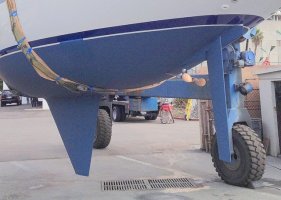Well, it sounds to me like you were carrying too much sail. In 25 knots on a beam reach, the E32-3 is comfortable with a double reef in the main and maybe a jib at J or less.
In 30 knots, a third reef in the main and scrap of jib.
In 40 knots, a scrap of jib gives complete control and a fairly comfortable ride.
Few boats steer well when heeled far over, and our boat doesn't like it at all. The 32-3 heels quickly to 15 degrees, and more than that is nearly always detrimental. Reduce sail accordingly. Other boats may not be reefed yhet.
The design is well rounded, meaning it does nearly everything well, and performs under either main or jib alone. But it doesn't stand up to clouds of sail, and downwind it doesn't surf to achieve the high momentary speeds of more recent hull shapes.
It's not a racing boat in any sense of the word. Six or 7 knots is the best to expect, and in a seaway that will be an active ride.
Dead downwind in heavy air the design rolls enthusiastically. I think a spinnaker would help, don't have one myself.
The wild yawing you experienced is the result of imbalanced sails. For any given condition, try more main and less jib, or less main and more jib.
Do whatever is necessary to reduce or eliminate weather helm, which makes the rudder a brake.



